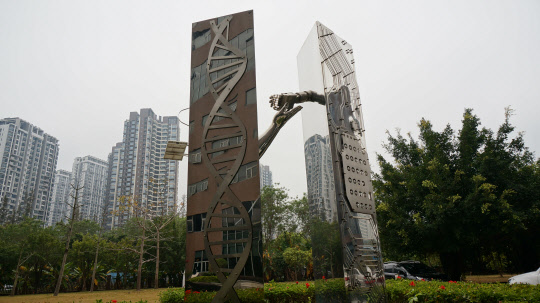[Reportage] Visiting SIAT Shenzhen…. Total incubating enterprise value- KRW 4 trillion
Nam Do Yeong | namdo0@ | 2017-03-06 11:03:29

Photo = A statue in the Shenzhen Institutes of Advanced Technology (SIAT) of Guangdong province, China. DNA double helix on one side pillar and semiconductor shape on another pillar have been placed and the two pillars symbolizes Bio Technology (BT) and Information Technology (IT) converged ‘BIT’ technology development goal as hand shaking scene between pillars taking place.
■2017 Restart Korea
Reportage. Visiting Shenzhen SIAT-‘the center of technology innovation center’ of China
‘Chinese medical device companies have independently developed Magnetic Resonance Imaging (MRI) and Computed Tomography (CT) devices to compete with companies like Siemens and Philips’.
Shia Hong Liu- Assistant manager of the industry, commerce and energy, expressed his confidence in Chinese medical device technology, whom we met at Shenzhen Institutes of Advanced Technology (SIAT) in Shenzhen, Guangdong province on February 23,.
He mentioned, ‘The technology of MRI-based initial detection screening of cancer is ahead of the world, and a proposal for cooperation has been coming in from American companies. We are planning to enter Southeast Asia and Africa based on these technologies.’
Prejudices like Chinese medical devices are inexpensive and low quality has already become a thing of the past. The average research and development (R & D) investment of Shenzhen medical device companies accounts for 10-25% of the total sales of products, and 70% of the produced medical device products own intellectual property rights.
The grow engine for the rapid evolution of Chinese medical devices was the power of research institutes such as SIAT to support technology. SIAT is a research institute jointly established by Chinese Academy of Science, Shenzhen City and Hong Kong Chun Mun University in Shenzhen, the largest start-up city in China. Approximately 2,000 researchers are working on innovation in areas such as healthcare, alternative energy, new materials, robots, big data, and smart cities. Especially, ``BIT``- convergence of Information Technology (IT) and Bio Technology (BT), is a key research theme.
SIAT has a specialized capability in application technology, technology commercialization, and technical cooperation to support the Shenzhen that has become a mecca of Chinese cutting edge technology industry. SIAT is pursuing a ``micro innovation system`` strategy that integrates research, education, investment as well as industry with self-employed and doctoral educational institutions and incubation facilities such as ``Changeac Academy``. As a result of this achievement, the company has raised about KRW 10 billion worth of patents annually for about 1,000 partner companies and has incubated 450 high-tech enterprises, resulting in a total market value of KRW 4.20 trillion.
The competitiveness of SIAT is in ``open innovation``. SIAT was the first institution, which was co-established with high academic institutions in Hong Kong, and since its establishment time, has expanded its network of innovation to Hong Kong, Macau, Taiwan as well as Singapore. Recently, Nobel Prize winner and others are spurring on the recruitment of world scholarship in order to increase the competitiveness of the research.
Rita Kuang-general manager of international cooperation department of SIAT said, ‘We provide CNY 1 million annually for overseas talents, and if the research team comes in from overseas, the government supports CNY 100 million in settlement of the research team and CNY 10 million in equipment cost. A virtuous cycle of attracting talent is happening as foreign researchers recommend other talented people based on their experience.’
Rita Kuang also mentioned that Korea is also a major target for cooperation with SIAT along with the US and Europe, especially in the electronics and IT sectors.
Mr. Shia stated, ‘The curved glass manufacturing technology for smartphone depends on the import of all of its own technology, which is only owned by Korea. On the other hand, there is no company that developed MRI, so 7.0 MRI developed using SIAT``s software and core parts technology is being developed. And we will be able to consider introducing and selling completed equipment.’
Shenzhen (China)=By Nam Do Yeong namdo0@
